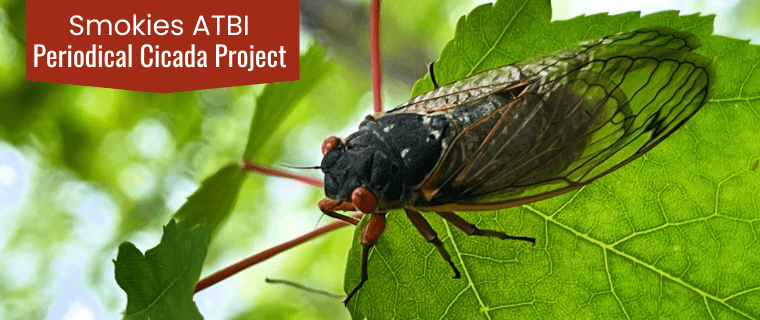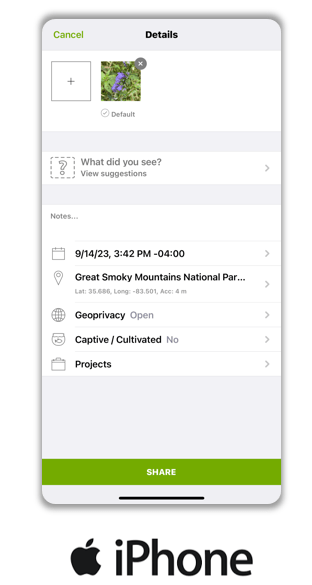
Periodical Cicada Survey Brood XIV 2025
🔎When to survey 🔎What to Look and Listen For 🔎Where to Survey 🔎Tips for using iNaturalist
Periodical Cicadas Brood XIV are emerging and we want your help to find out what species are being found and where in Great Smoky Mountains National Park!
Please follow all park rules and regulations, as well as follow Leave No Trace ethics.
Follow sightings on the iNaturalist project: inaturalist.org/projects/periodical-cicadas-in-the-smokies
When to survey
Between now (late April) and mid-June. The cicadas are starting to emerge but take a few days after emerging to begin calling, so this is a great time to start recording! If you want to repeat the survey another time or two, that would be even better. A humid warm day, where it’s not super rainy would be best, though they will probably call in a light rain.
What to listen and look for
You’re aiming to find periodical cicadas (genus Magicicada). All species in this genus look similar: black body, red eyes, amber color on their wings. Each species has subtly different body coloration and calls. These should be the only cicadas out right now (the green annual cicadas will emerge later in the summer), so any cicadas you see or hear are our target group.
Most periodical cicadas this year will be 17-year cicadas from Brood XIV. There are 3 species from Brood XIV: Magicicada cassini, Magicicada septendecim, and Magicicada septendecula.
The 3 species all sound and look a little different. You are just listening for a buzzing in the trees and do not need to know how to tell them apart, but you can click on the species names above to listen to the characteristic sound of each.
There are also “stragglers” from past or future Broods emerging as well. So far, one has been identified as a straggler of Brood XIX which emerged in 2024. Getting a recording and photographing a specimen will help determine an individual’s brood.
Where to survey
See maps and links below for more details.
- FHP East near I-40 – drive the entire Foothills Parkway from I-40 to Cosby
- FHP-Walland – Survey the area underneath the Foothills Parkway at Walland, along Old Walland Hwy. This is probably better done on foot.
- FHP West driving route – This route along the entirety of the western Foothills Parkway and into the Abrams Creek area (44 miles, approx. 3 hours driving time, with frequent stops) – map with route
- Cades Cove Loop – Drive along the Cades Cove Loop Road and also Sparks and Hyatt Lanes
- Other areas of the Park at relatively low elevation – you can see the Park boundary on this map
Here are a few options of places to go and routes to take:
- FHP East near I-40 – drive the entire Foothills Parkway from I-40 to Cosby

- FHP West driving route – This route along the entirety of the western Foothills Parkway and into the Abrams Creek area (44 miles, approx. 3 hours driving time, with frequent stops) – map with route

- FHP-Walland – Survey the area underneath the Foothills Parkway at Walland, along Old Walland Hwy. This is probably better done on foot

- Cades Cove Loop – Drive along the Cades Cove Loop Road and also Sparks and Hyatt Lanes

- Other areas of the Park at relatively low elevation – you can see the Park boundary on this map
Recording and posting to iNaturalist
It’s important to record audible sounds of the cicadas calling so other folks can identify their species-specific calls through iNaturalist.
- Before you go out: make sure one of your phones has the iNaturalist app downloaded to it and that you’ve signed into iNaturalist through the app. It’ll help to have a car charger or battery pack with you, just in case it runs low.
- When you hear a cicada: Open the iNat app and click Observe (bottom center, camera icon), then Record Sound. You’ll be prompted to record a sound clip through your iPhones default sound recorder. Record about 30 seconds of the sound, pointing your phone toward the calling cicadas and trying not to speak or shuffle your feet during the recording. Follow prompts to use this sound recording.
- Try this, though I don’t know if you can do it in the iPhone version of the app: Click the PLUS sign at the top right then click the Camera icon. Use your camera to take a photo of the general habitat where you hear the calls–a photo of the trees mostly. Click through to OK your photo and it will be added to the observation with your sound recording. If you can’t do this, don’t worry about it.
- That will take you to the observation screen ➡️
- Click on “What did you see?”. This auto ID feature does not work on sound recordings, so just type the word “Magicicada” (the genus of periodical cicadas) and click OK. Back on the observation screen, double-check that something is filled in for the date and time and the location (it’s fine if the location is just lat/long coordinates). Now hit “Share” to submit this observation. If you have cell signal or are on wifi, it’ll upload to iNaturalist immediately. If you’re out of signal, it’ll wait until next time you open the app in an area with signal/wifi.


Please practice this at home before your survey to make sure you understand the process. Try it with say a calling bird (substitute “bird” or the actual name of the bird for the word “Magicicada” in the instructions above).
You can also photograph a few examples of cicadas you may see, via iNaturalist. Here are some tips:
- Post only one individual per iNaturalist observation
- Take multiple photos of that individual and submit them all in a single observation
- Try to get photos of the top, side, and underside of the individual so it can be properly identified. This will probably require you to grab the cicada and handle it. They are harmless and will not bite
- You may also include a photo of the habitat where you found the individual and even a sound recording, but only if it is a recording of that specific individual calling. Otherwise, post a separate observation of the calls you hear nearby
Questions? Send an email to jaimie@dlia.org or will@dlia.org.

